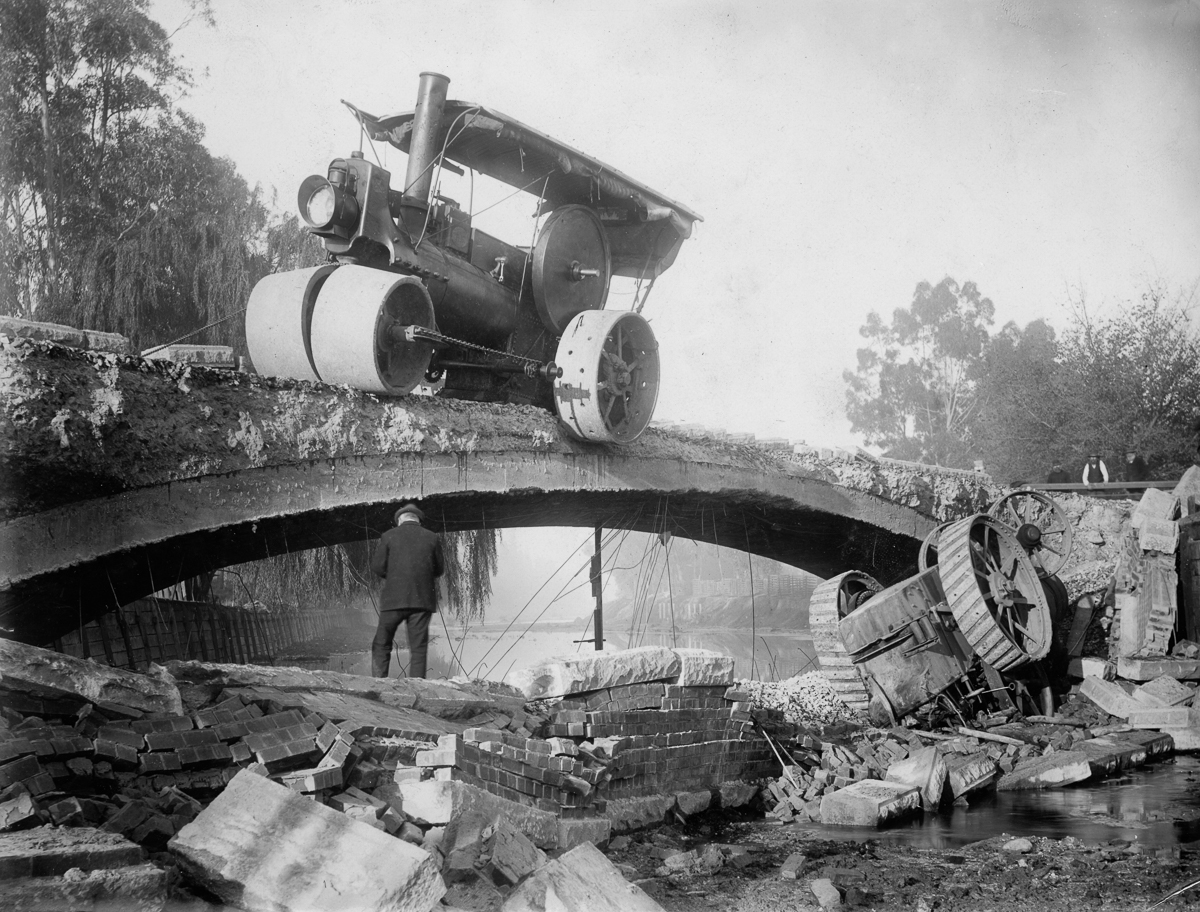

A SHOCKING ACCIDENT.SENSATIONAL COLLAPSE OF A MONIER BRIDGE.A WELL-KNOWN CONTRACTOR KILLED.SEVERAL MIRACULOUS ESCAPES.There was a tragic happening yesterday afternoon at 4.20 o'clock, at the King's Bridge, which resulted in the death of Mr. A. E. Boldt, of the well-known firm of Messrs. Boldt and Brasier, contractors and wood merchants, while a number of escapes were made, which the facts show to be nothing short of miraculous.
A series of tests were being conducted on the bridge which spans the Bendigo Creek near the junction of Lucan and Bridge streets, or to better locate it for the general public, which is situate between the gasworks and the Inglewood railway line.
The bridge, which was constructed on the Monier system, had been practically completed. The system is patented by the inventors throughout the world, the first of its kind introduced into Victoria being that which stretches across the Yarra at the Botanical Gardens.
The King's Bridge, which is one of several built, and in course of construction in Bendigo under the new loan, by the City Council, had a span of 93ft., and was in three sections, each being a complete arch.
MONIER ARCH BRIDGES IN BENDIGO
DISASTER AT KING'S BRIDGE
Bendigo Bridges
Eight Monier arch bridges were built along the Bendigo Creek in 1901 to 1902 using a new material - reinforced concrete. Six are still in use today
- Oak Street (Replaced)
- King's Bridge (Weeroona Mavenue)
- Booth Street
- High Street
- Wade Street
- Abbott Street
- Myrtle Street (Replaced)
- Thistle Street
You'll find more information about Bendigo's arch bridges at the Booth Street site - or scan the QR code below.
One Arch or Two?
Originally all eight bridges were designed as wide single arch structures. Following a shocking accident at the King's Bridge when a section of the arch collapsed during the load test - killing a contractor, Albert Boldt - the bridge was redesigned to have two spans and a central supporting pier, reducing stresses in the arches.
How did it happen?
The ability of a bridge to safely carry loads was tested by driving heavy vehicles over it. At King's Bridge, a steam roller and a traction engine were used for the test - together they weighed 30 tons which was far in excess of the load limit of 25 tons.
During the test, one section collapsed. The traction engine fell into the creek bed, dragging Mr Boldt with it and crushing him.
Monash & Anderson could not understand why the bridge had failed and engaged Professor William Kernot from Melbourne University to investigate. He concluded that the large angle of the skew had produced four times the expected stress in the bridge. Even today, engineers would find it difficult to analyse such a highly skewed structure.
Monash & Anderson rebuilt the bridge at their own expense.
The New King's Bridge
The two-span Monier arch bridge still carries traffic today. Alongside it is a new reinforced concrete arch bridge built in 2004. The road (now called Weeroona Avenue) was widened and a new road surface laid. However, from underneath, the two supporting structures can be clearly seen. The new King's Bridge was opened on 14 May 2004.
The Bendigo Creek
Sludge from the mines had been allowed to run into Bendigo Creek, filling up the creek bed which often caused floods. Engineers recommended clearing the sludge (which still contained some gold), realigning the creek, and protecting the banks with timber sheeting. Mines also had to better manage their tailings. After years of delay, work finally began on the creek in May 1899.
Geological map of the Bendigo gold field which shows historical features in superb detail, including mine shafts/companies, gullies, lines of reef, dams, and sand heaps. Originally prepared in the Bendigo Office, Mines Department, 1923. High quality, durable A1 print in a satin finish. Large, 594 x 891 mm. Go to online shop.